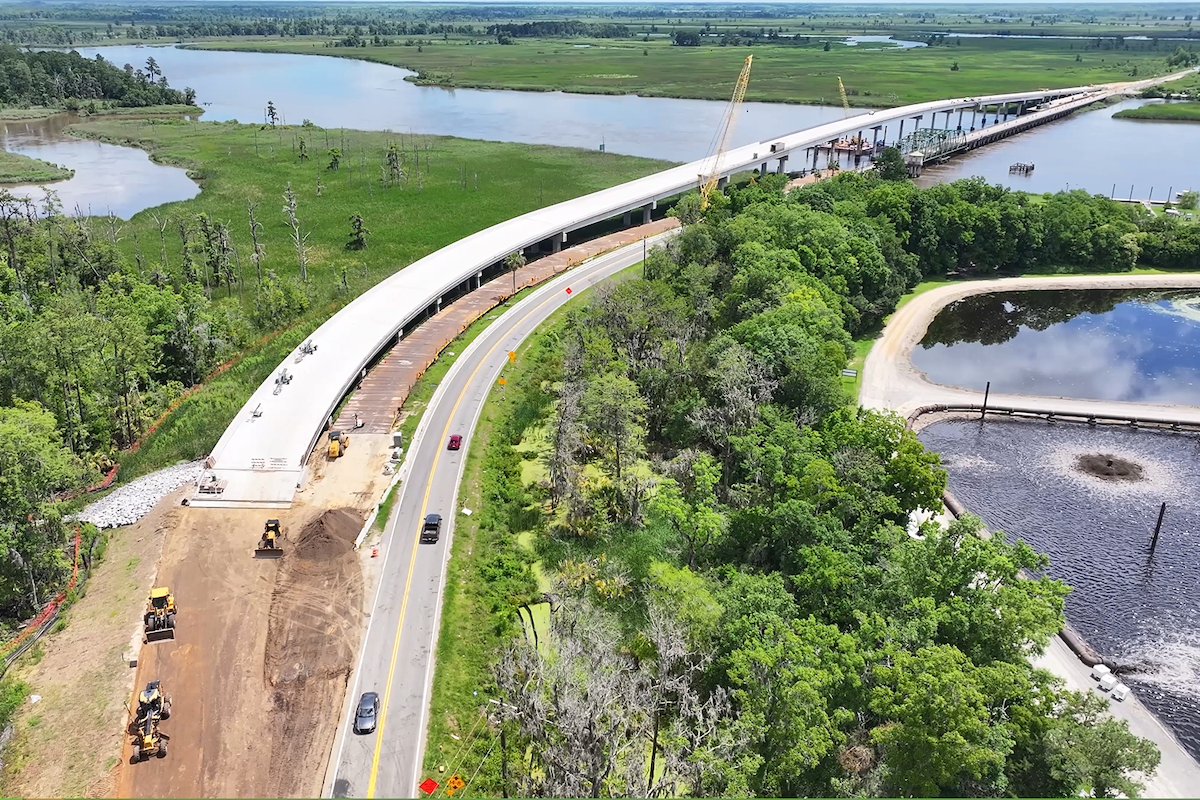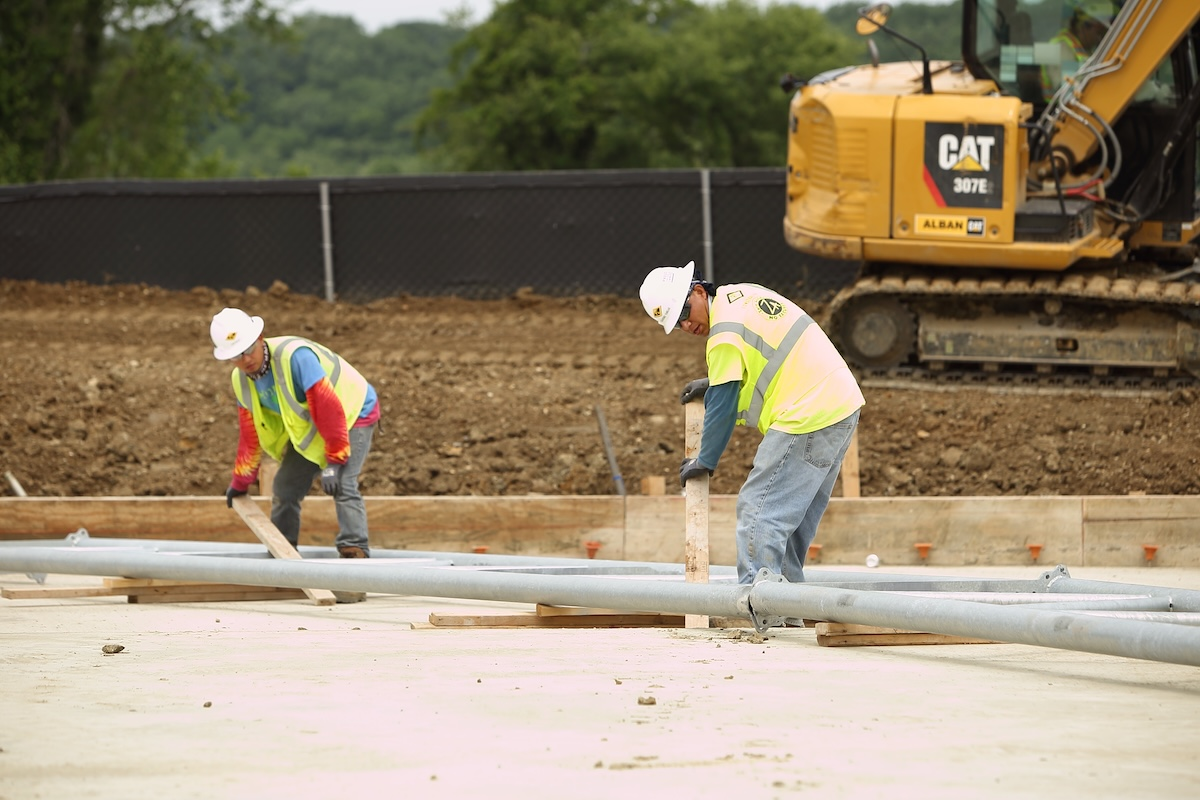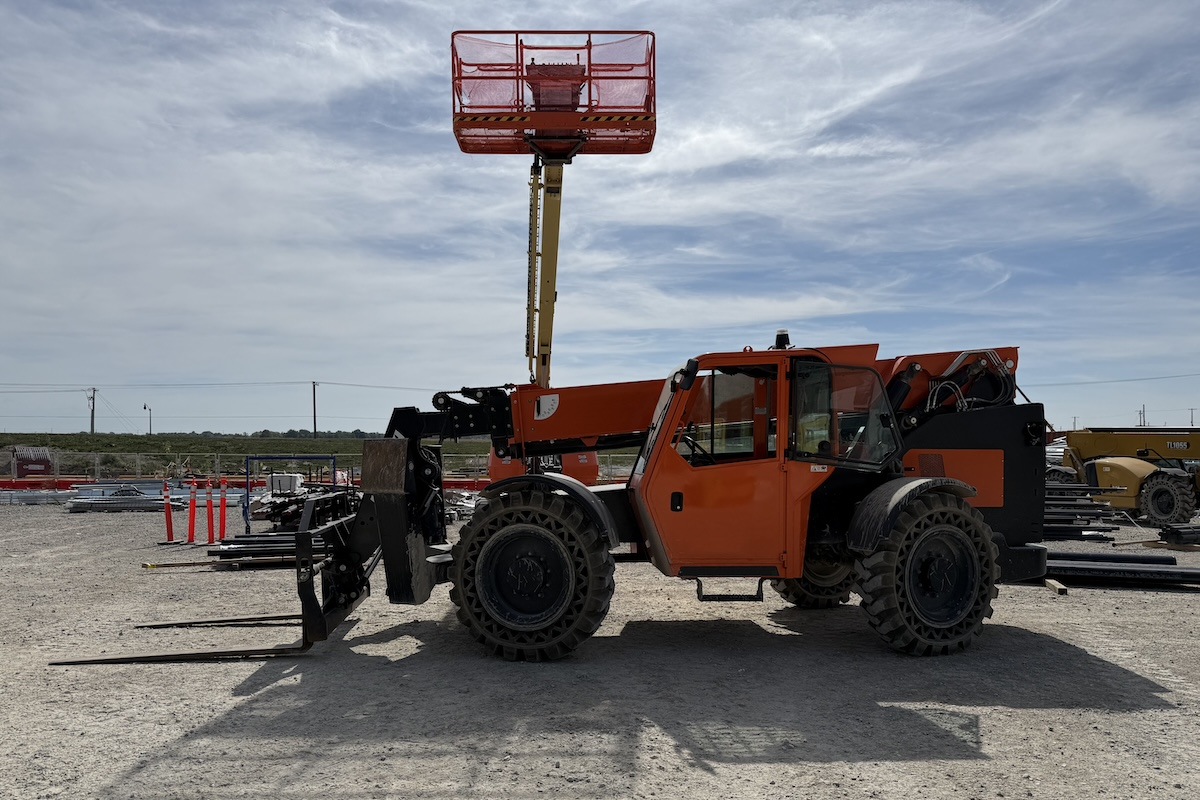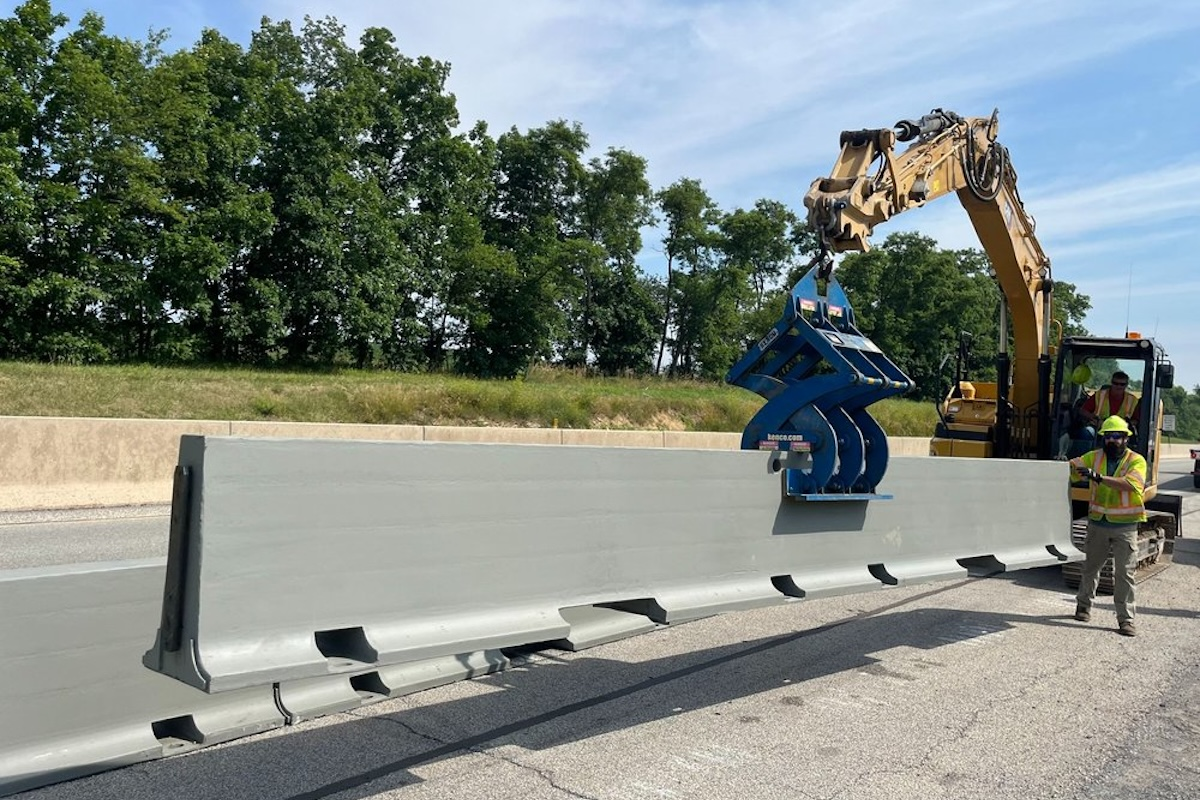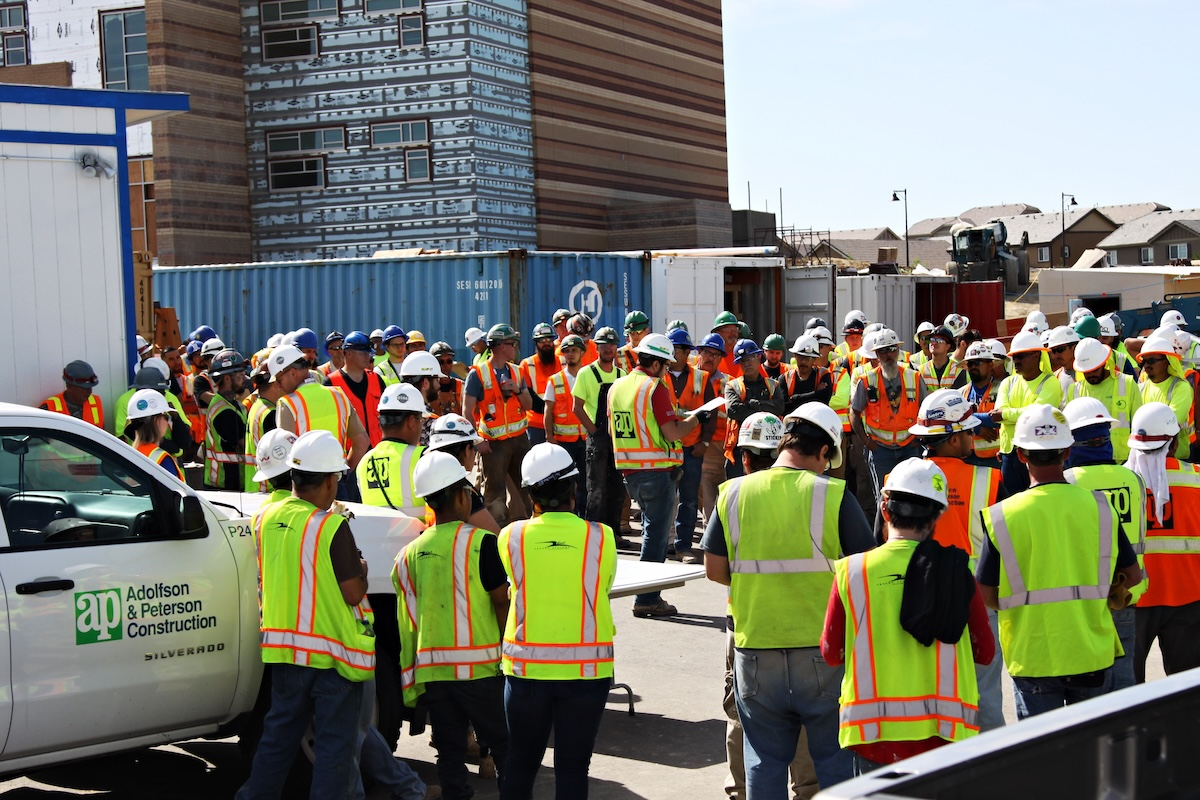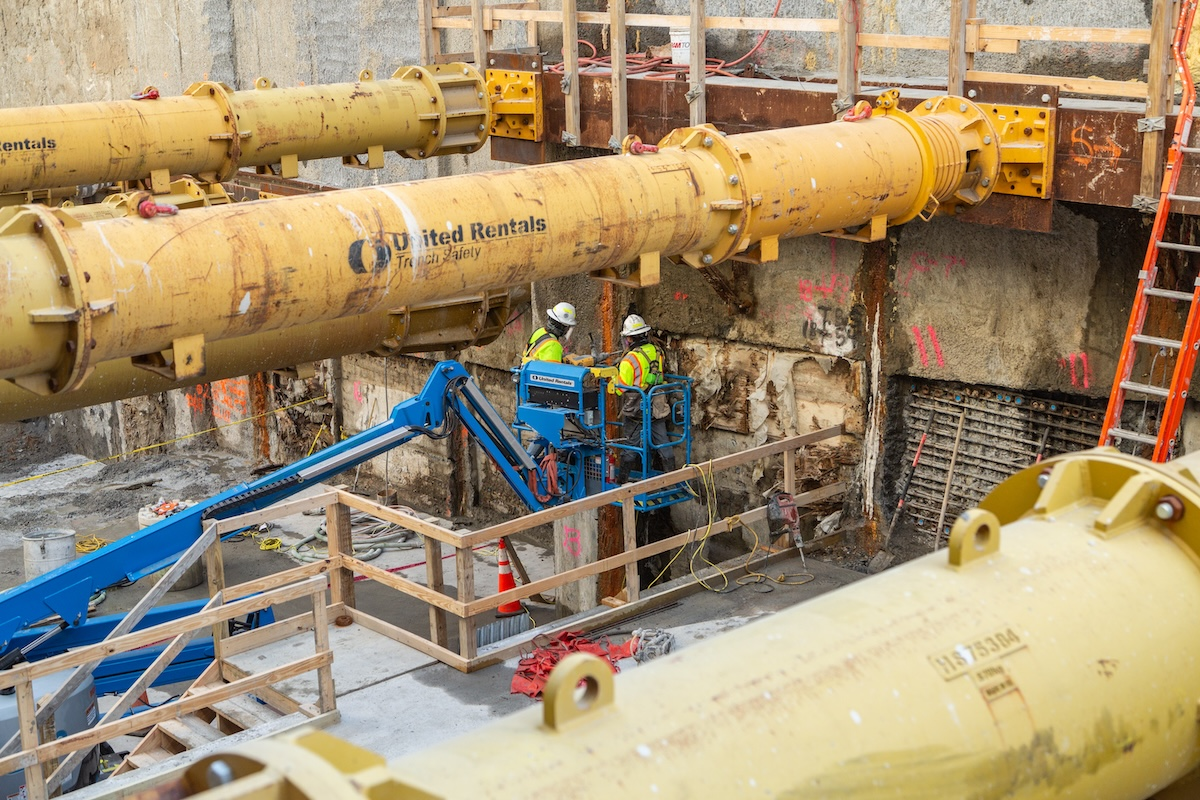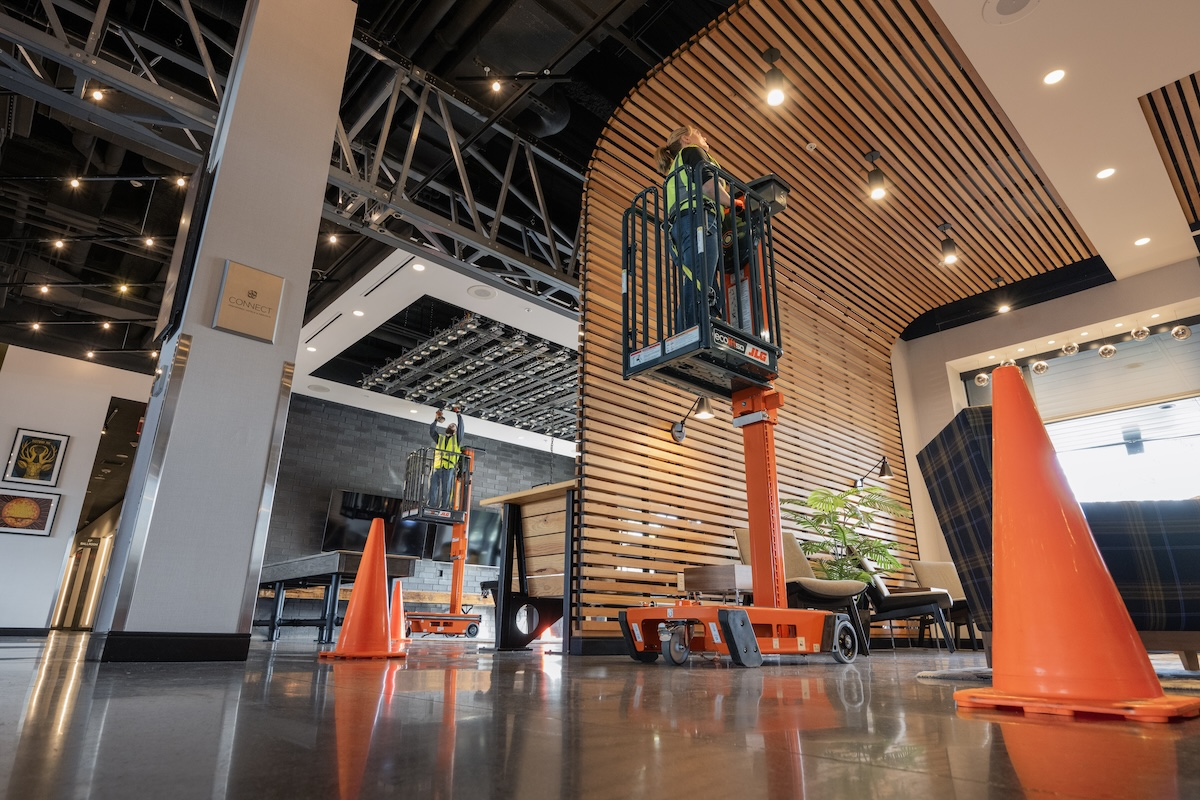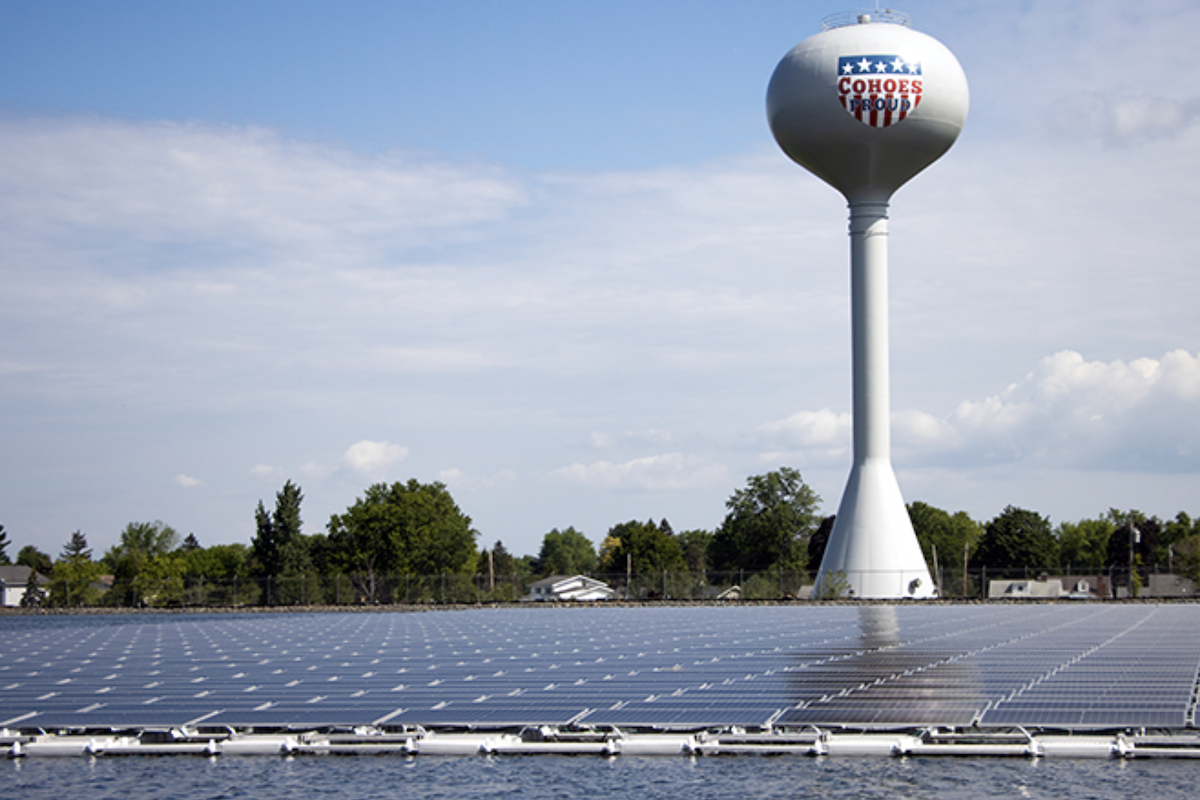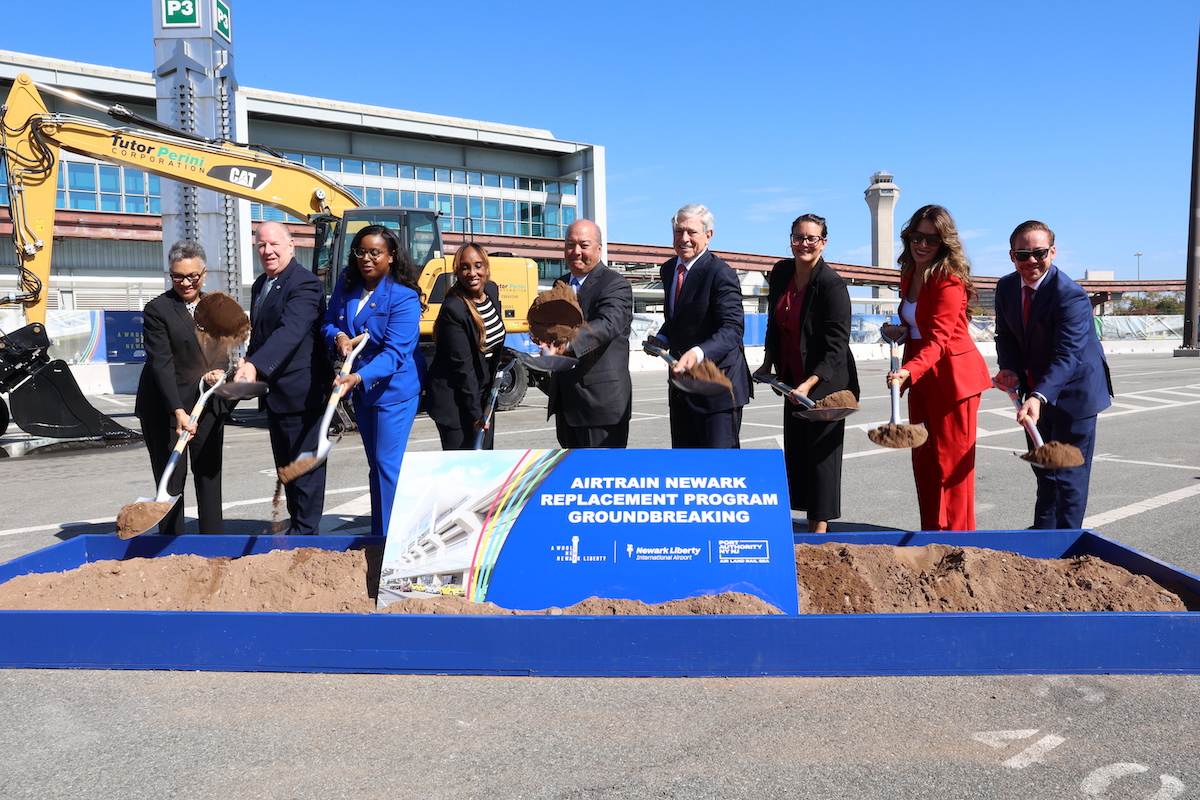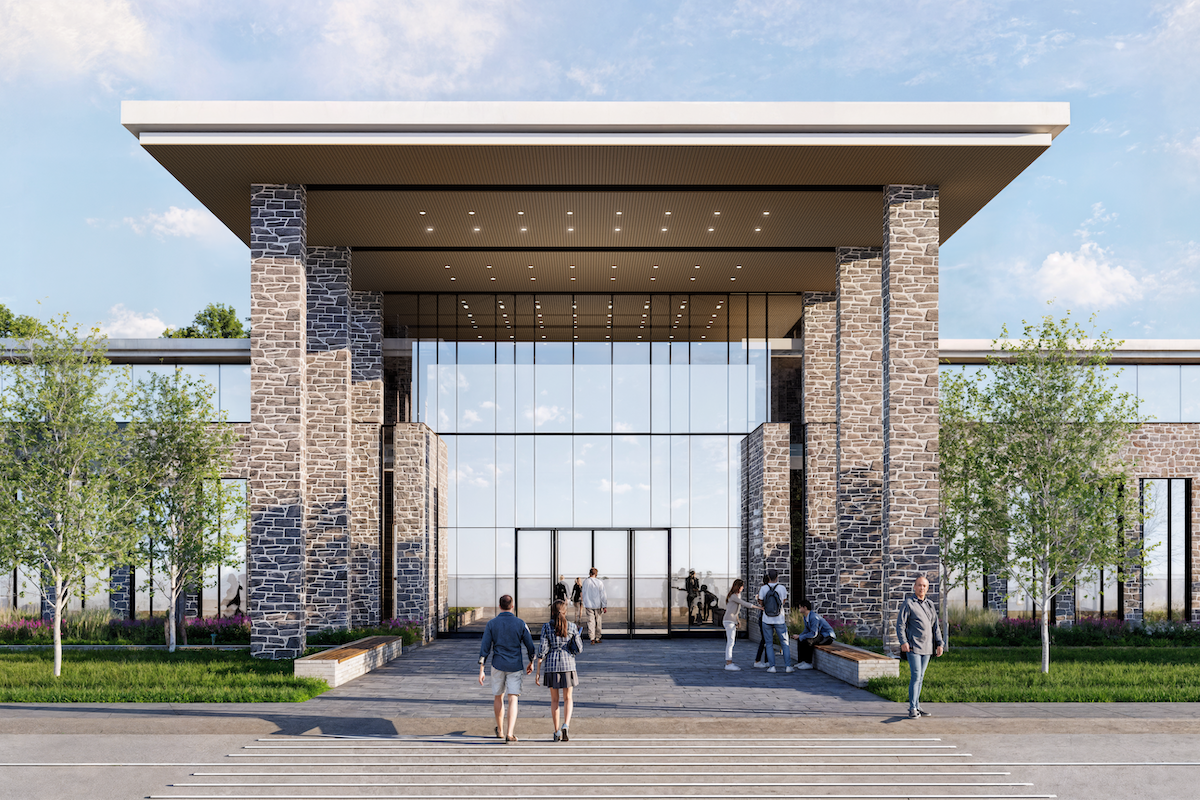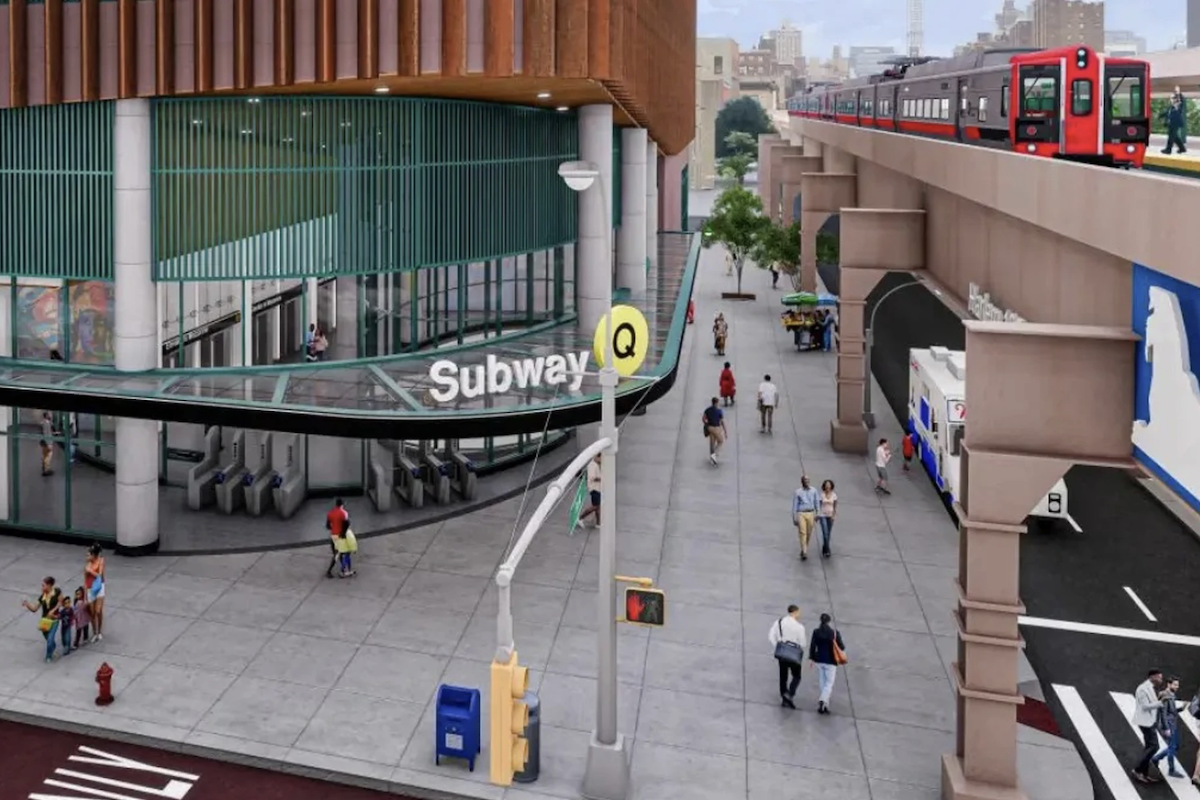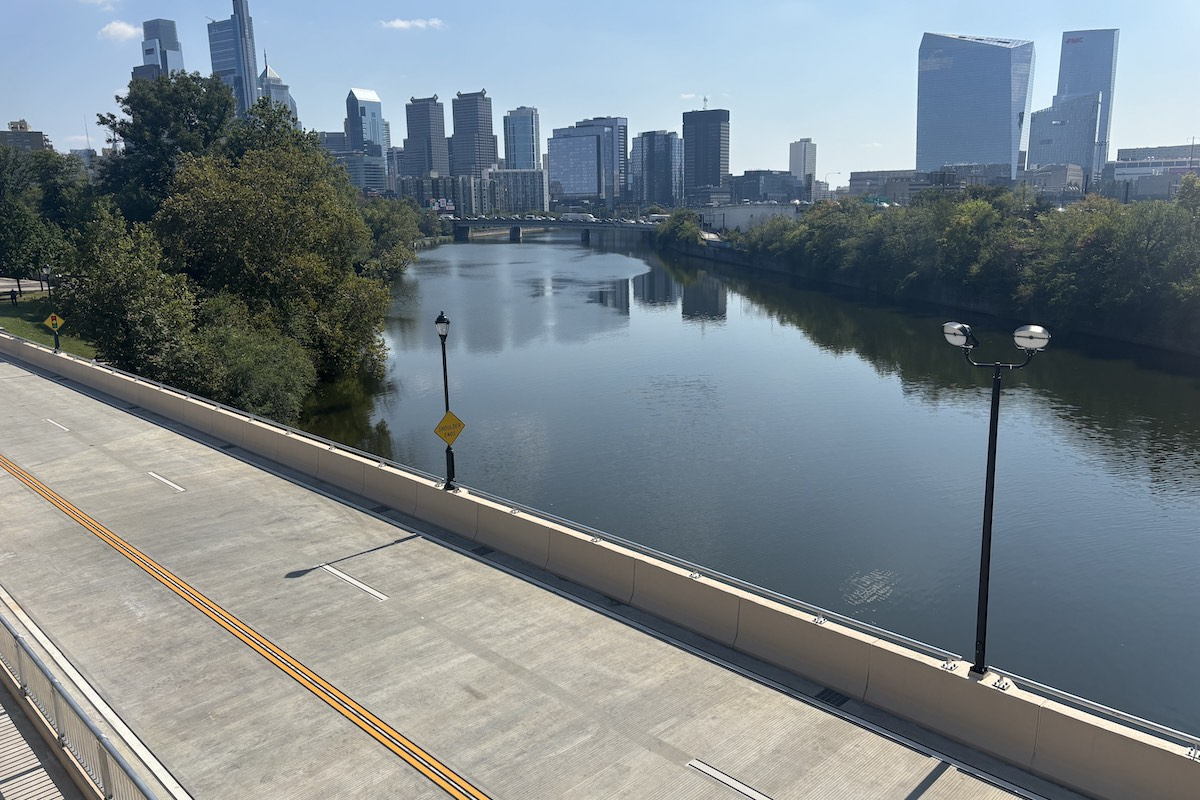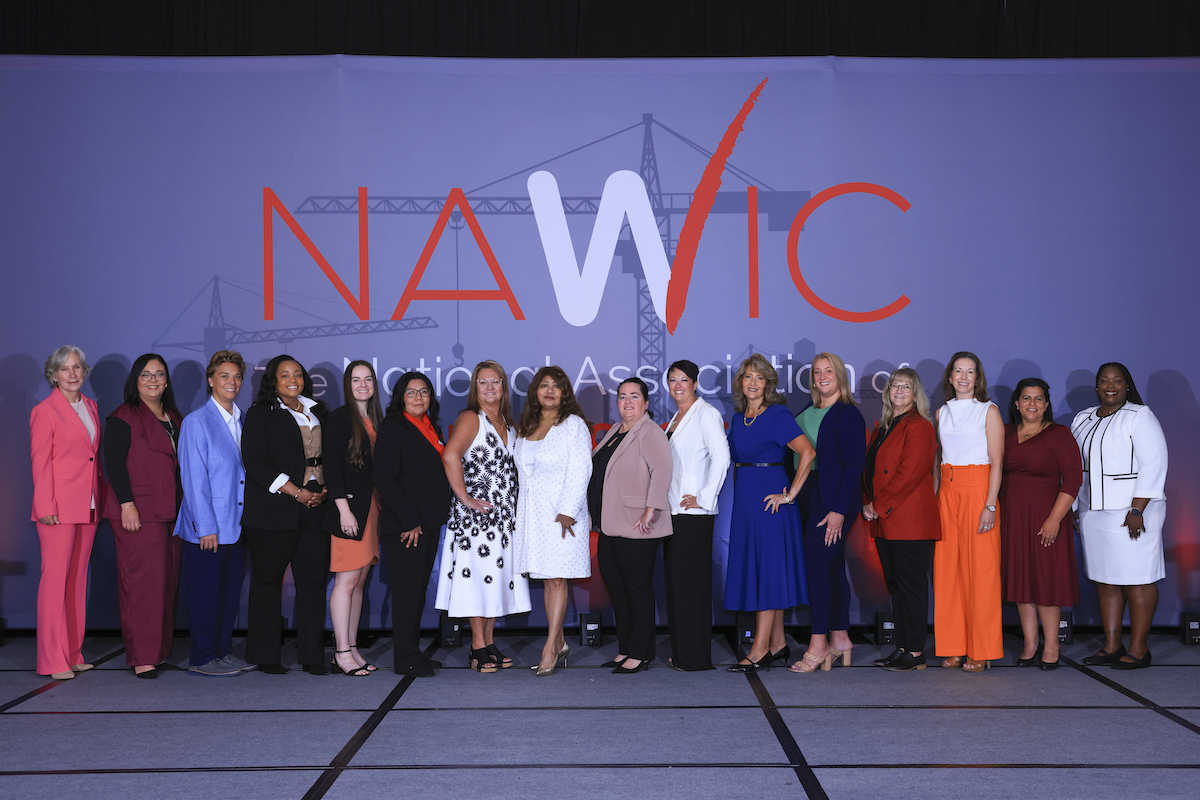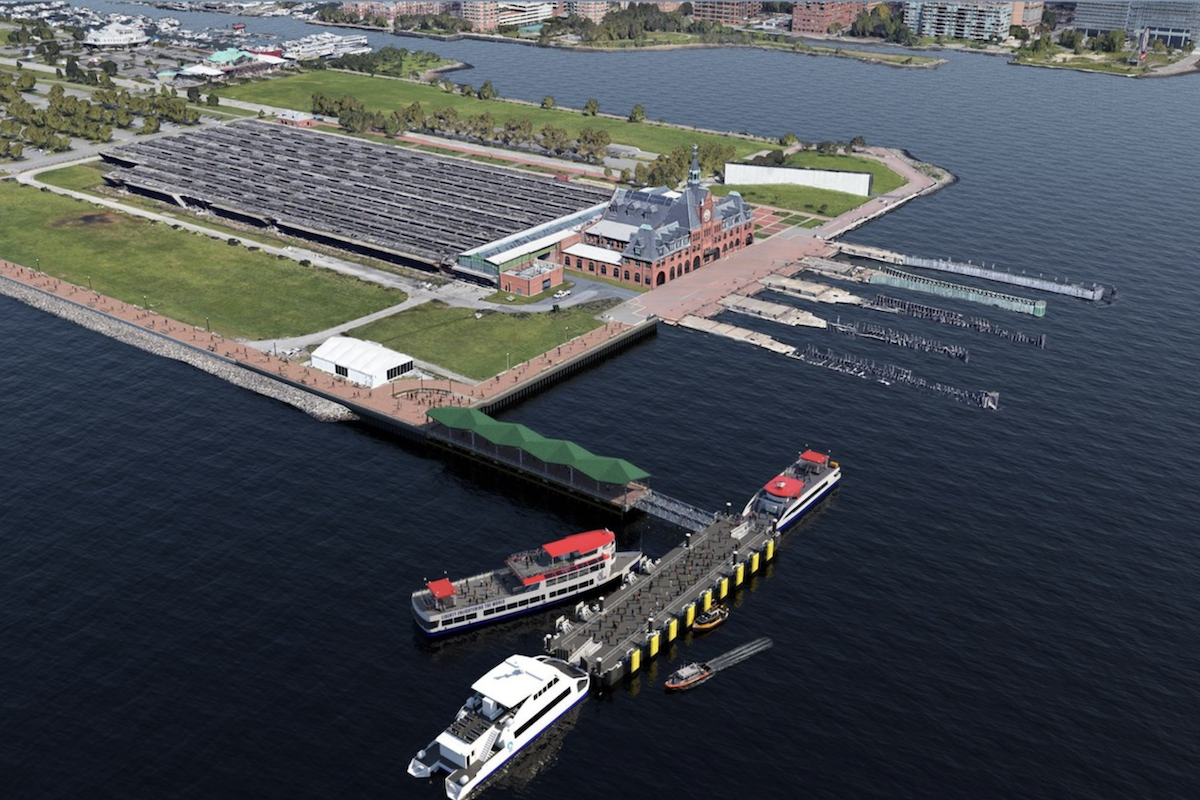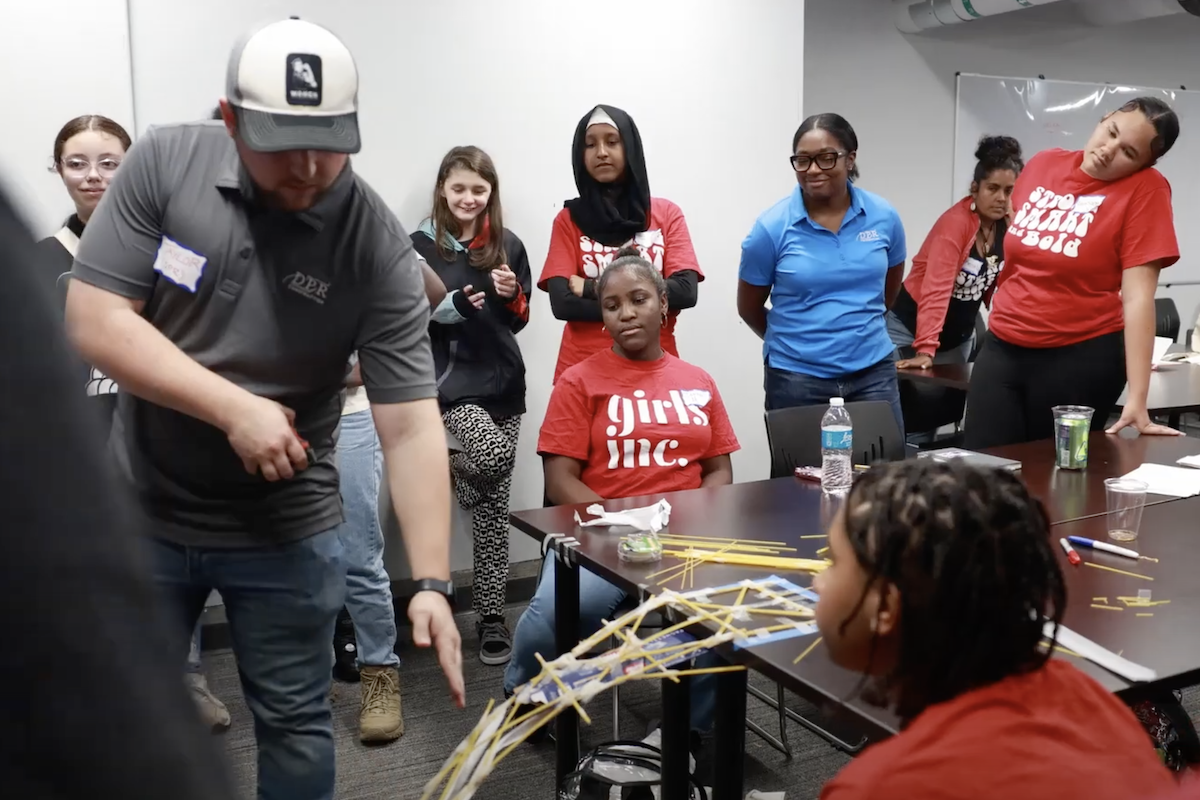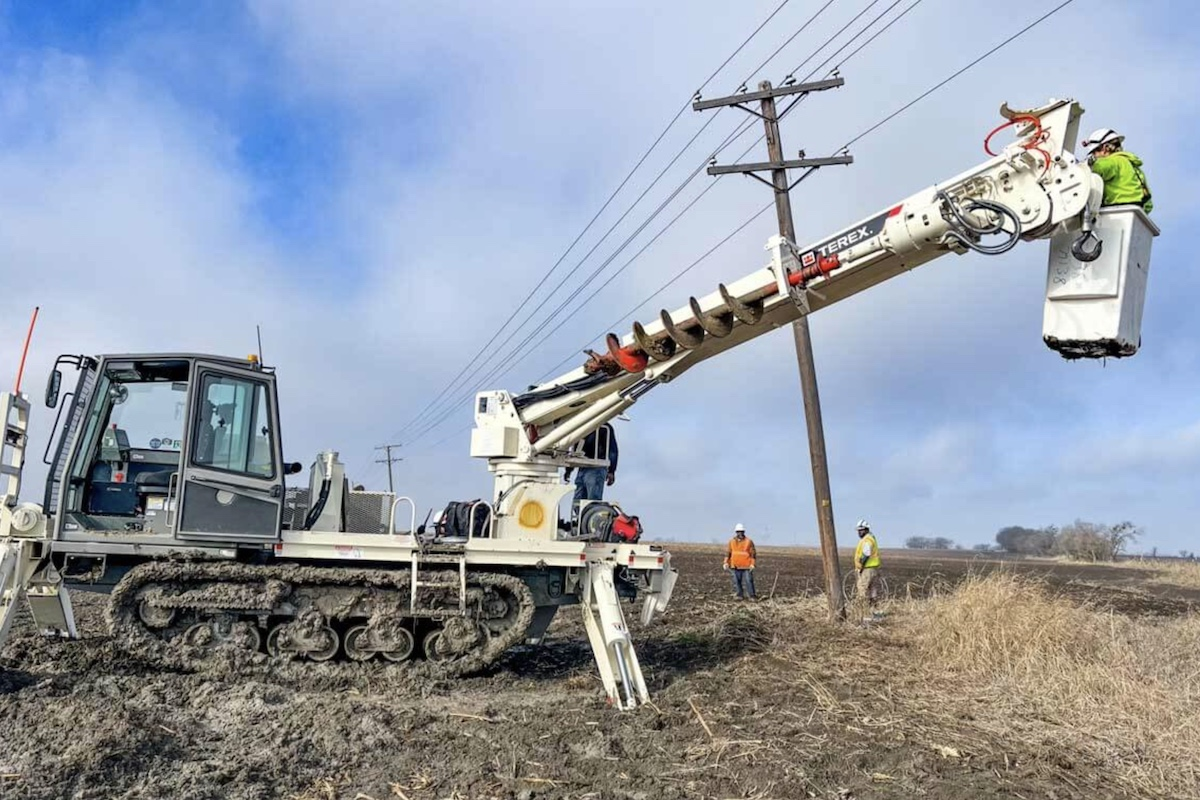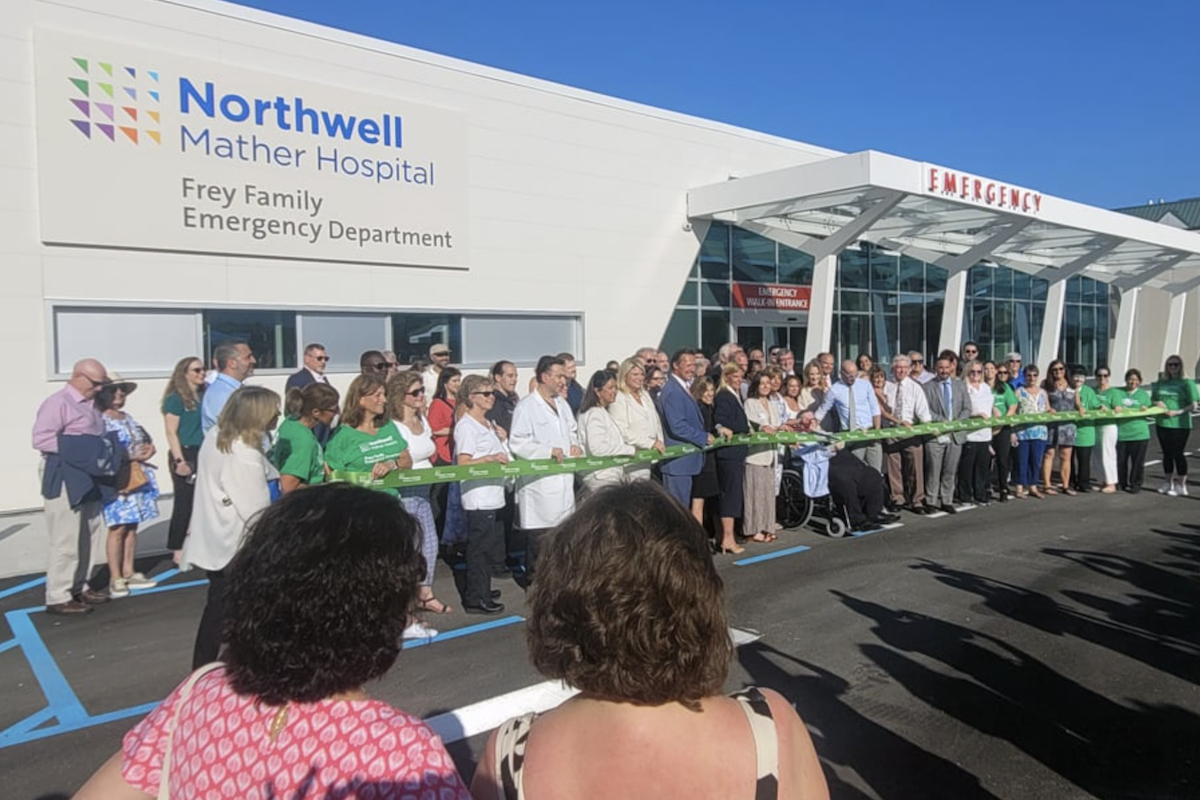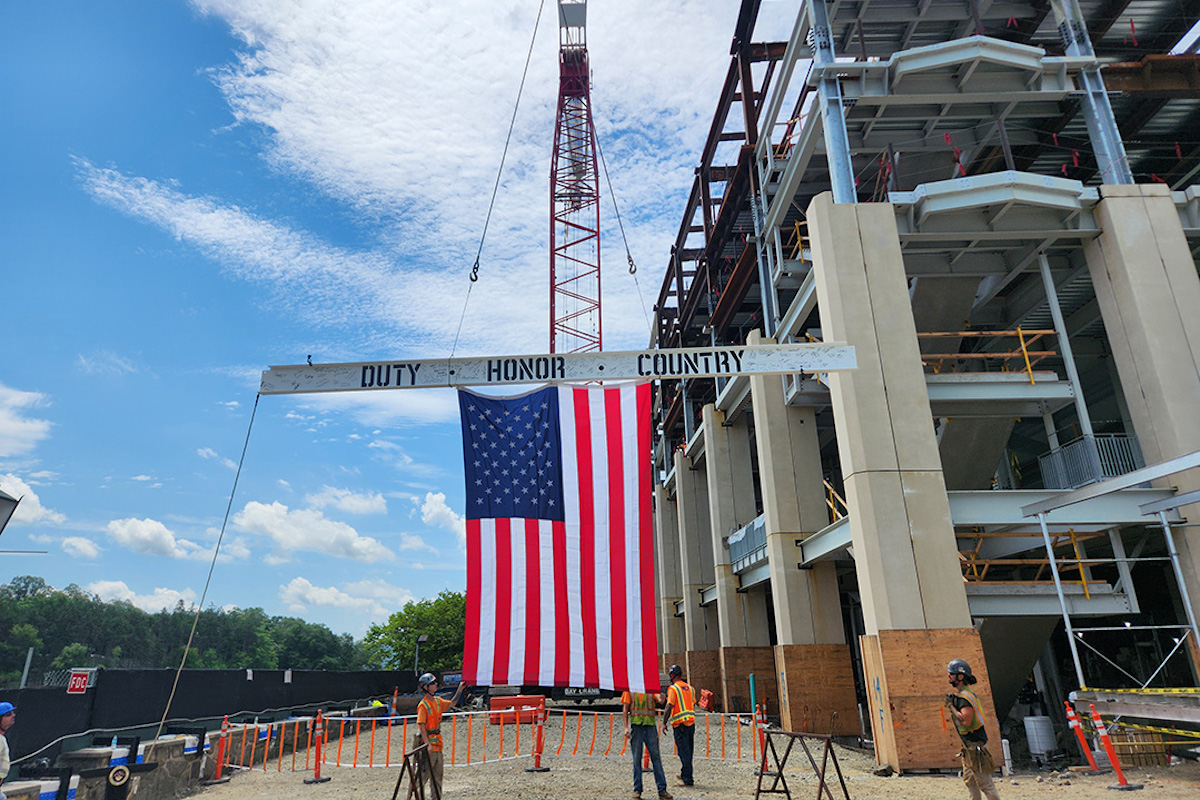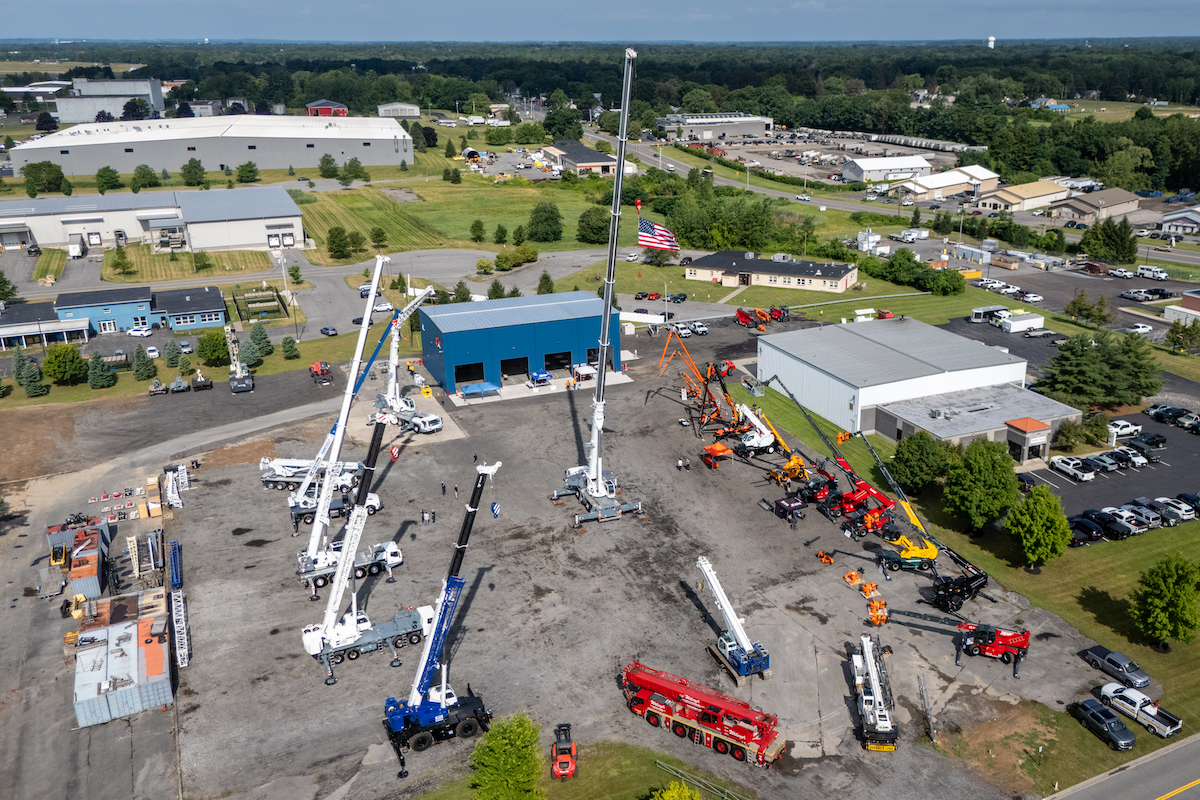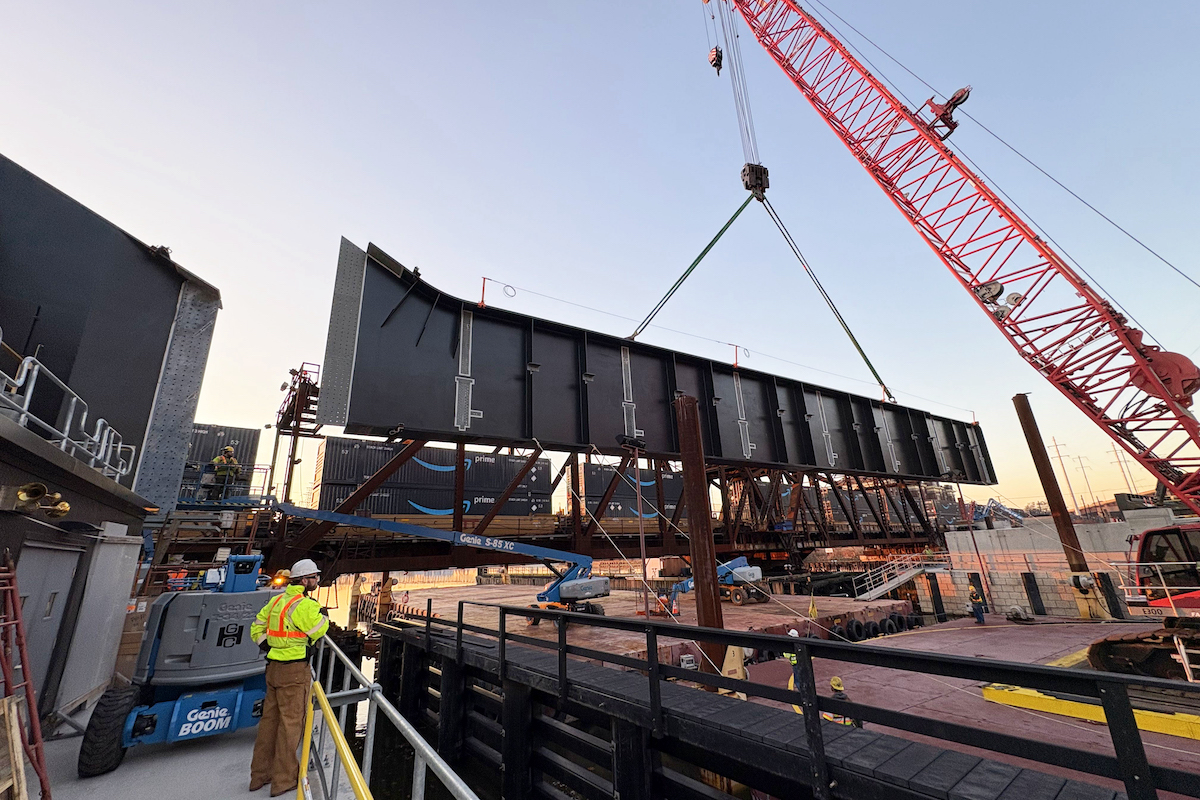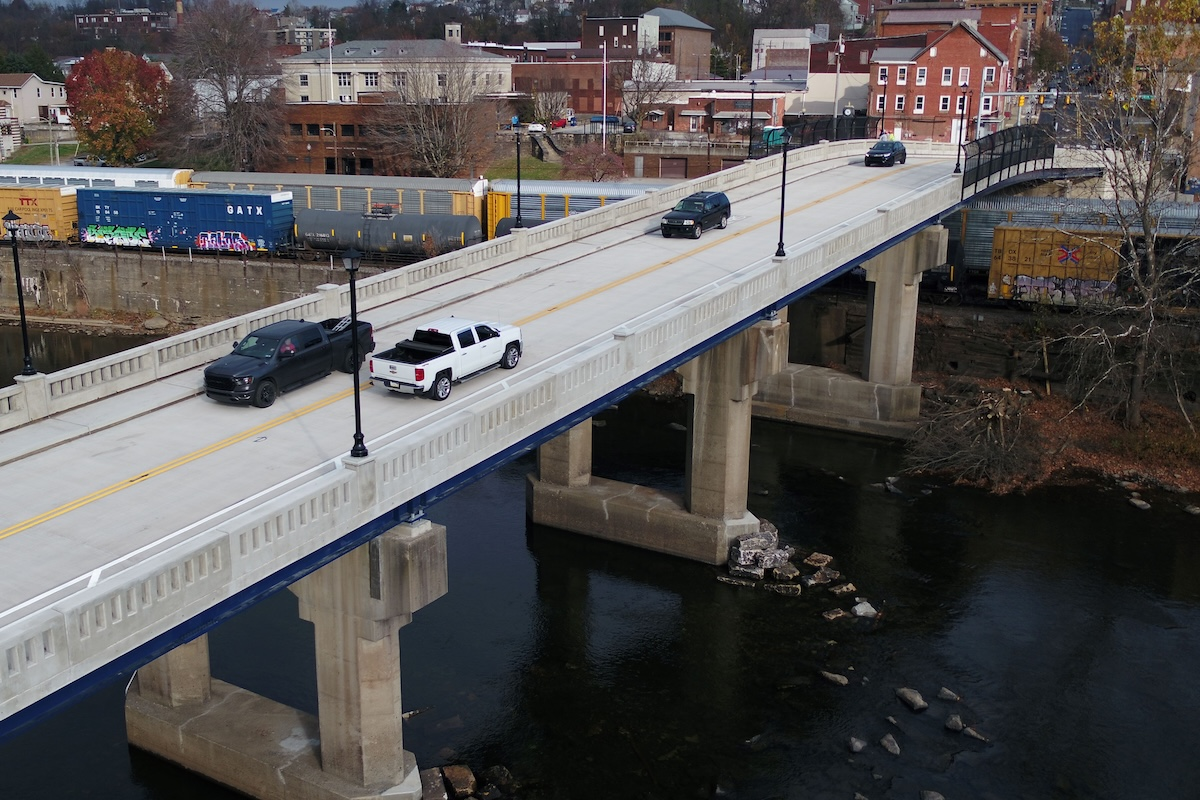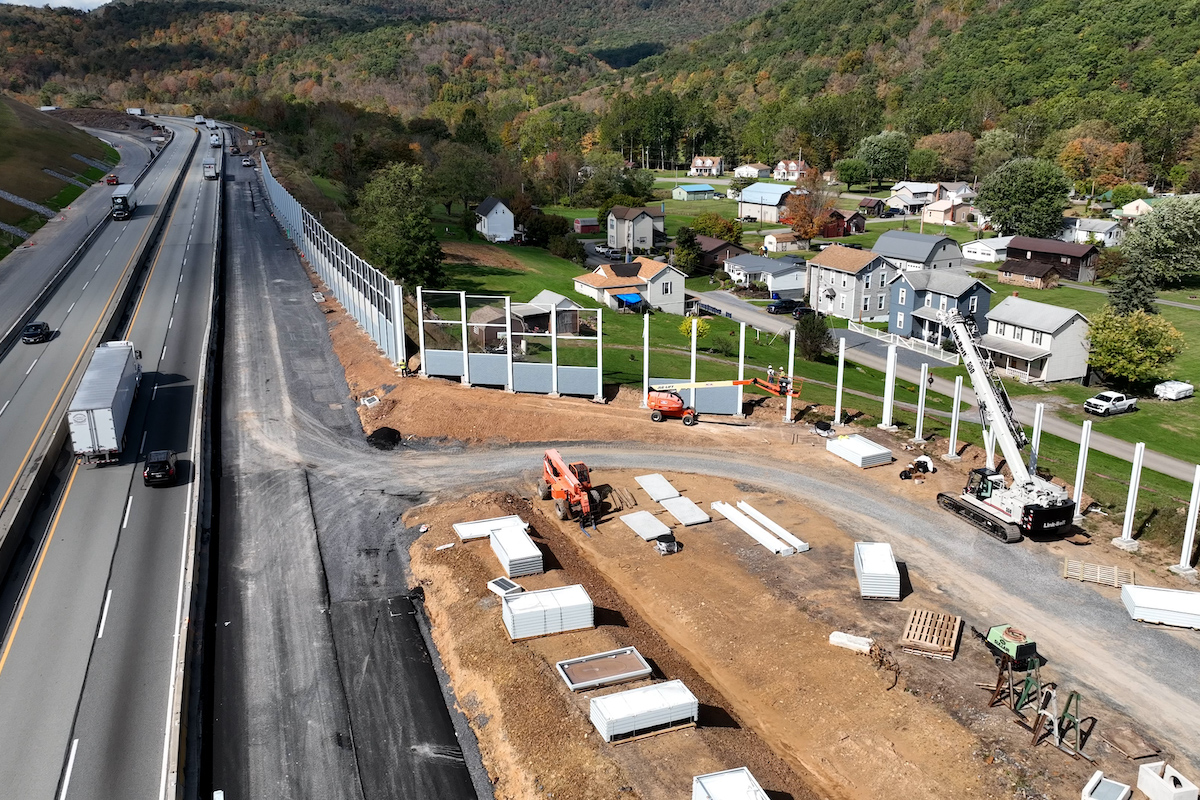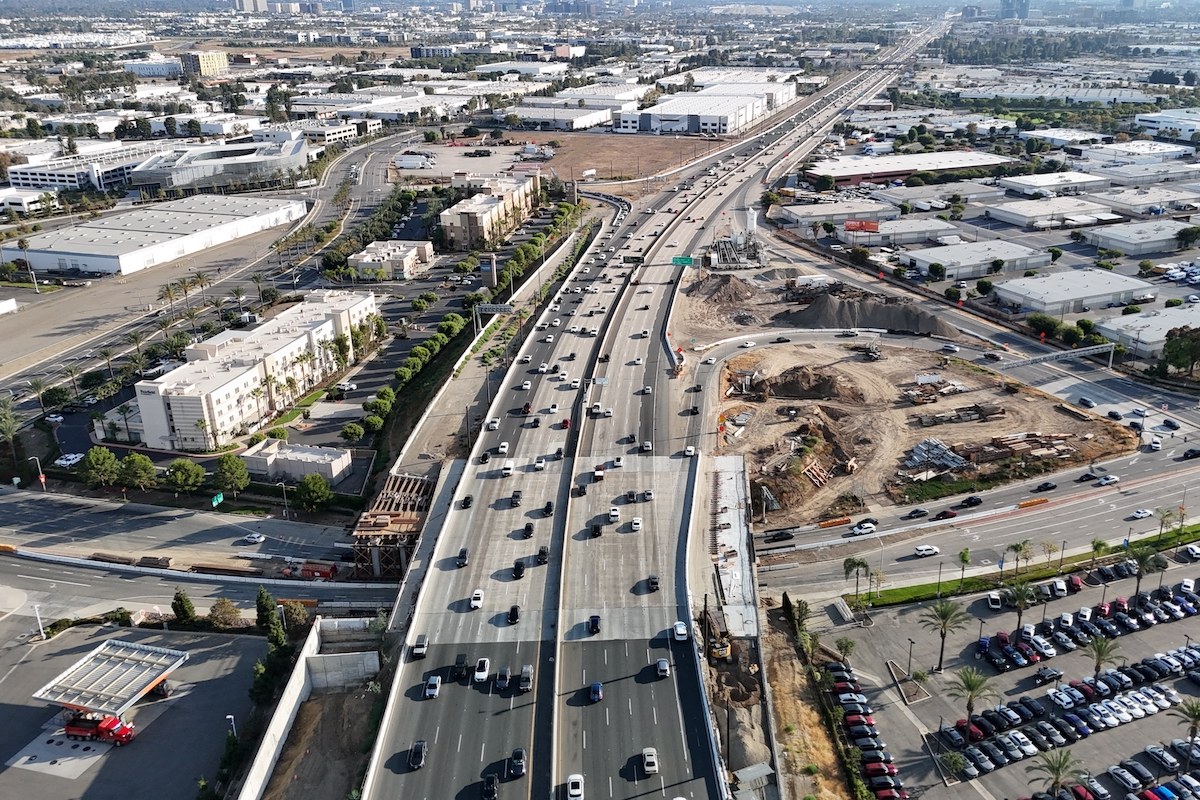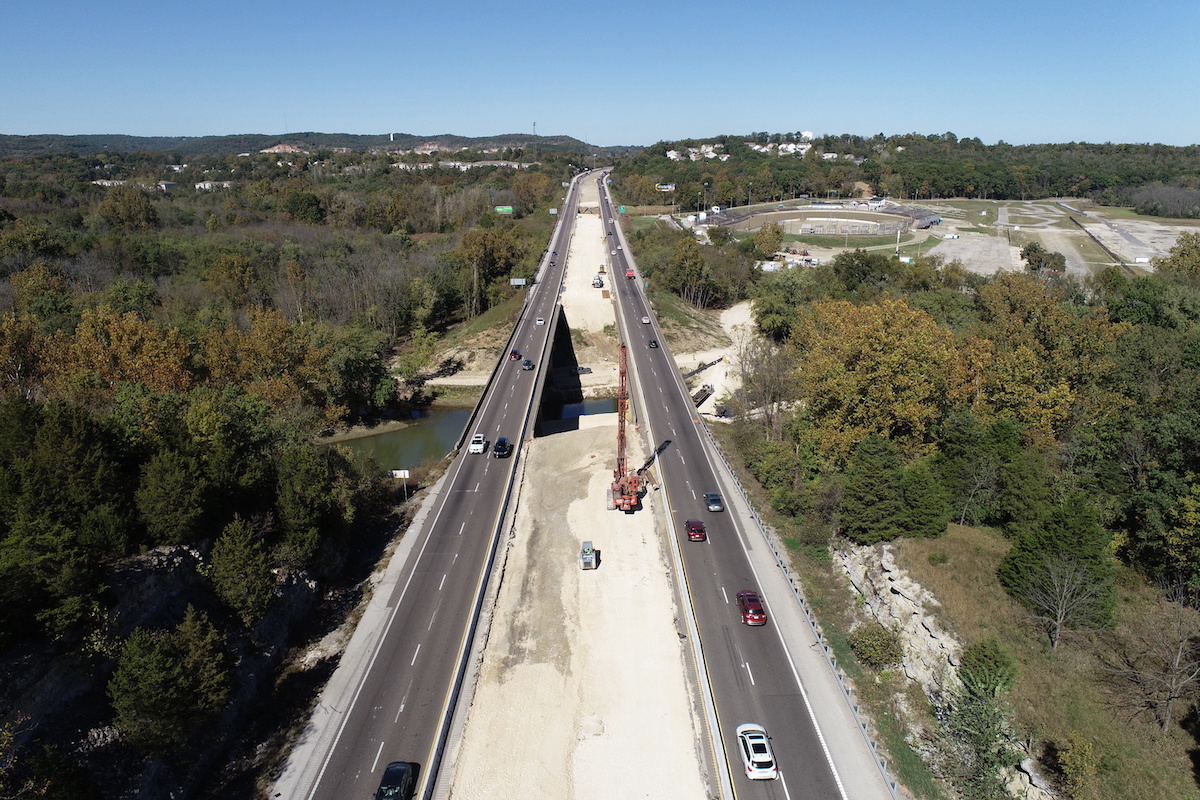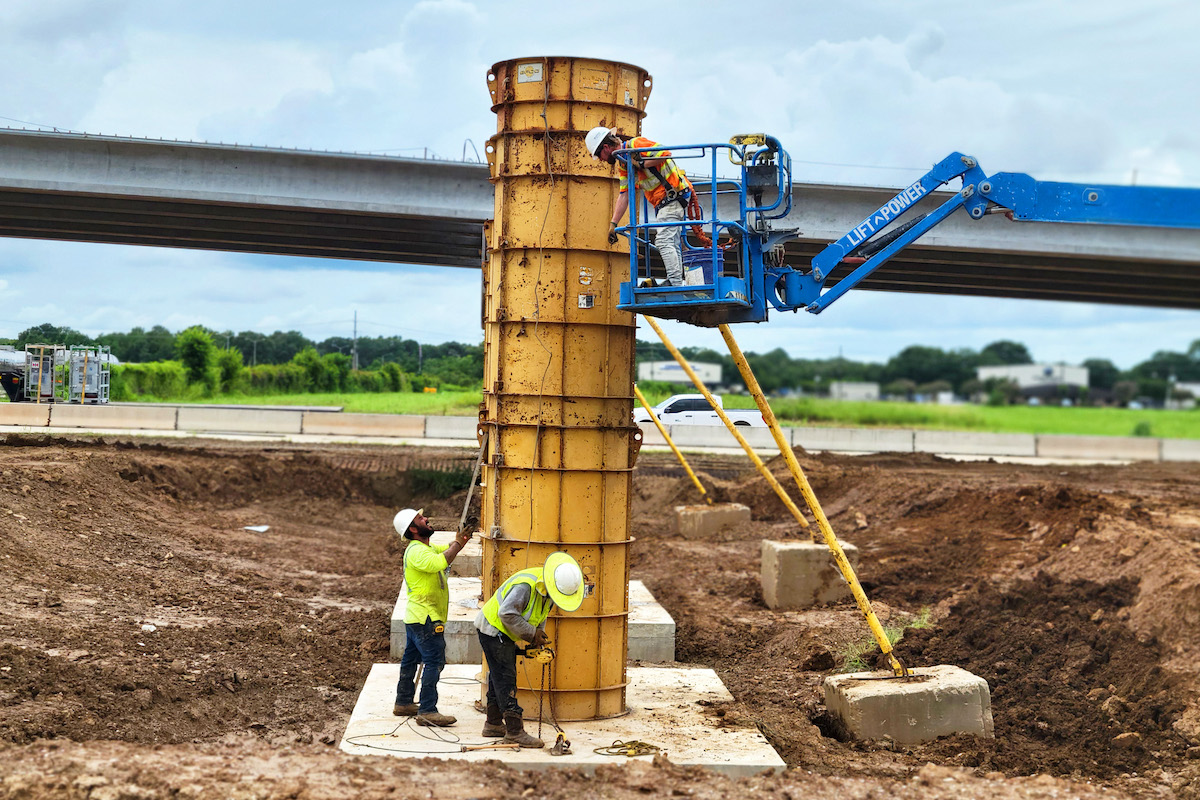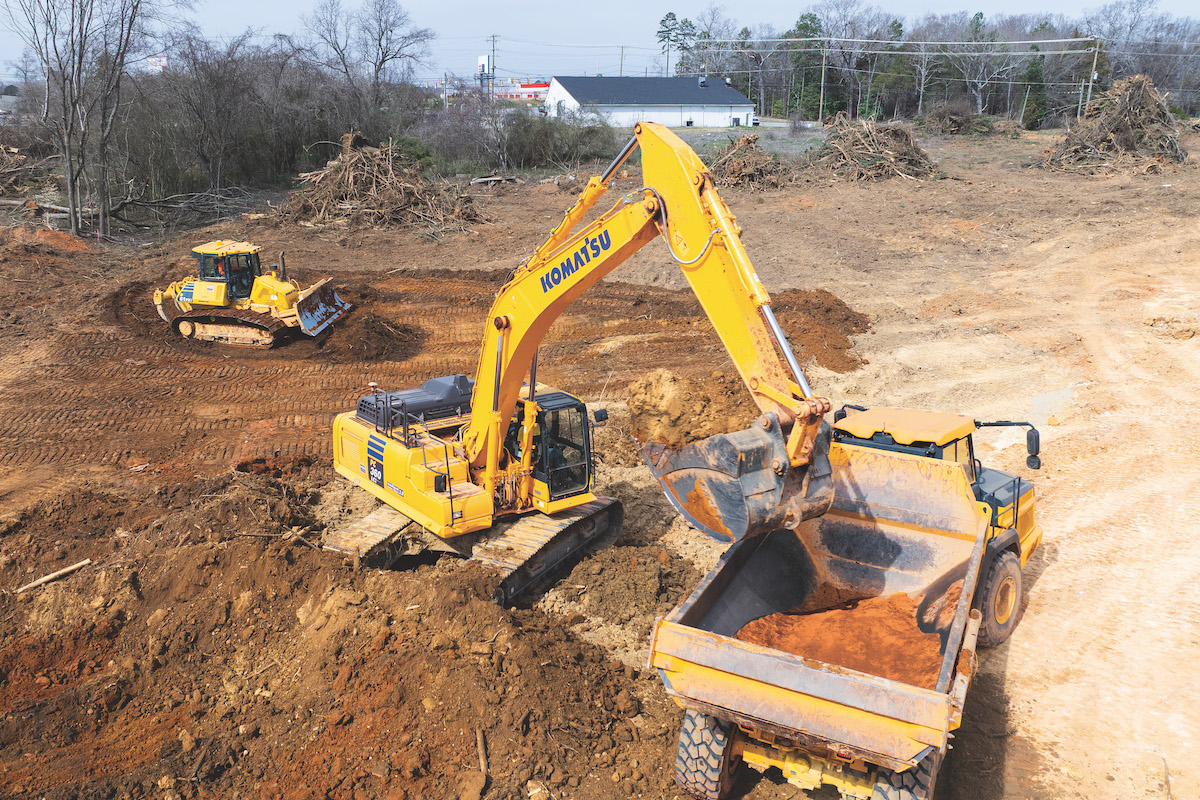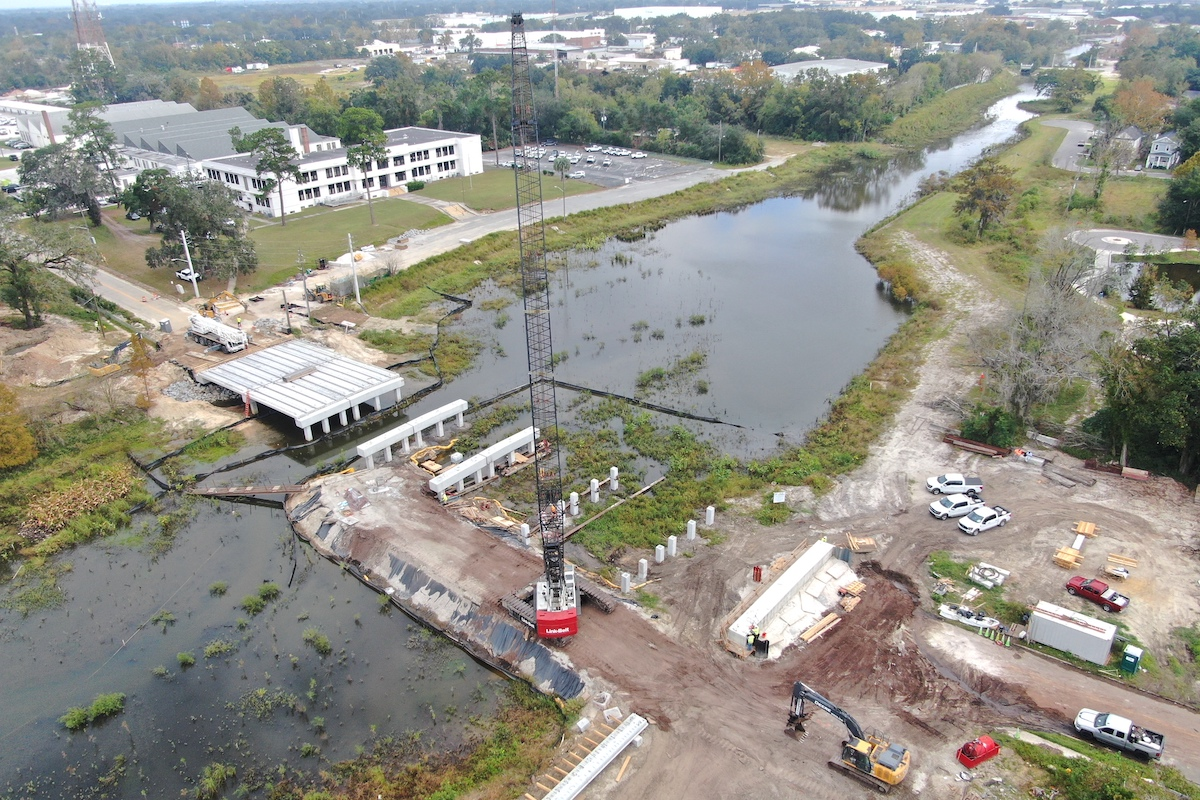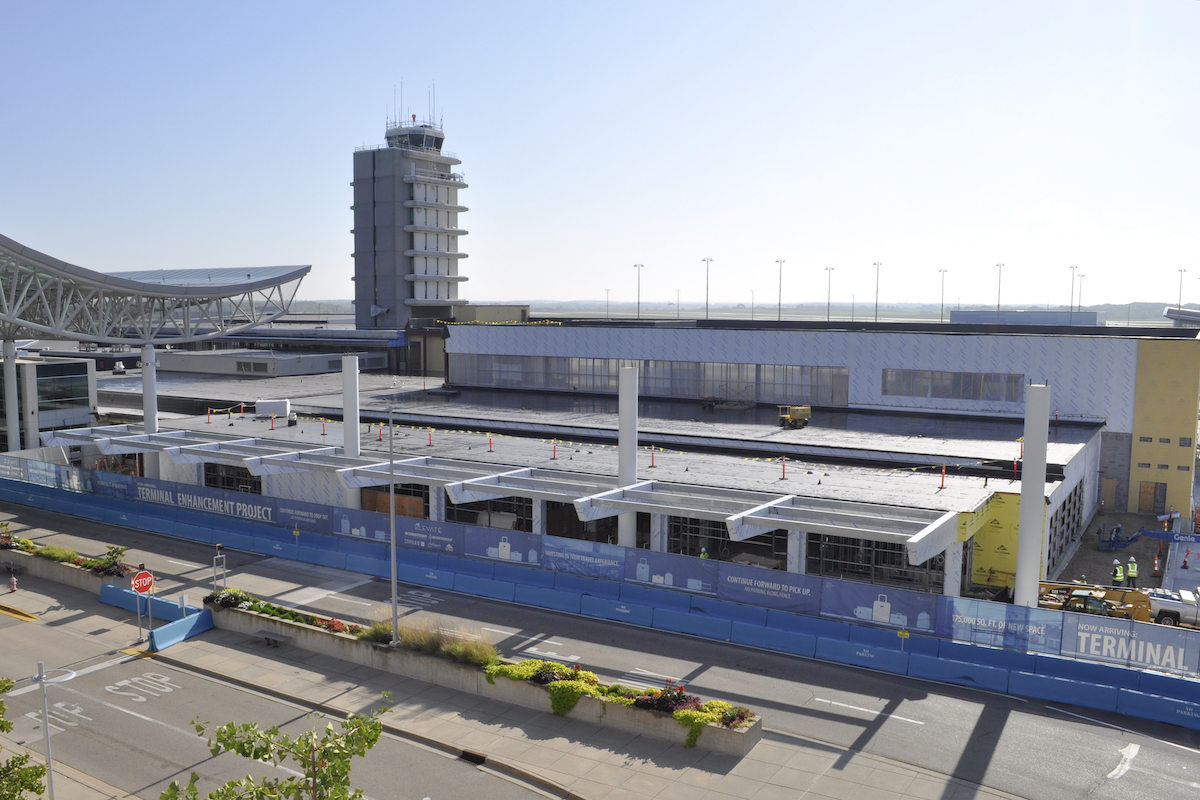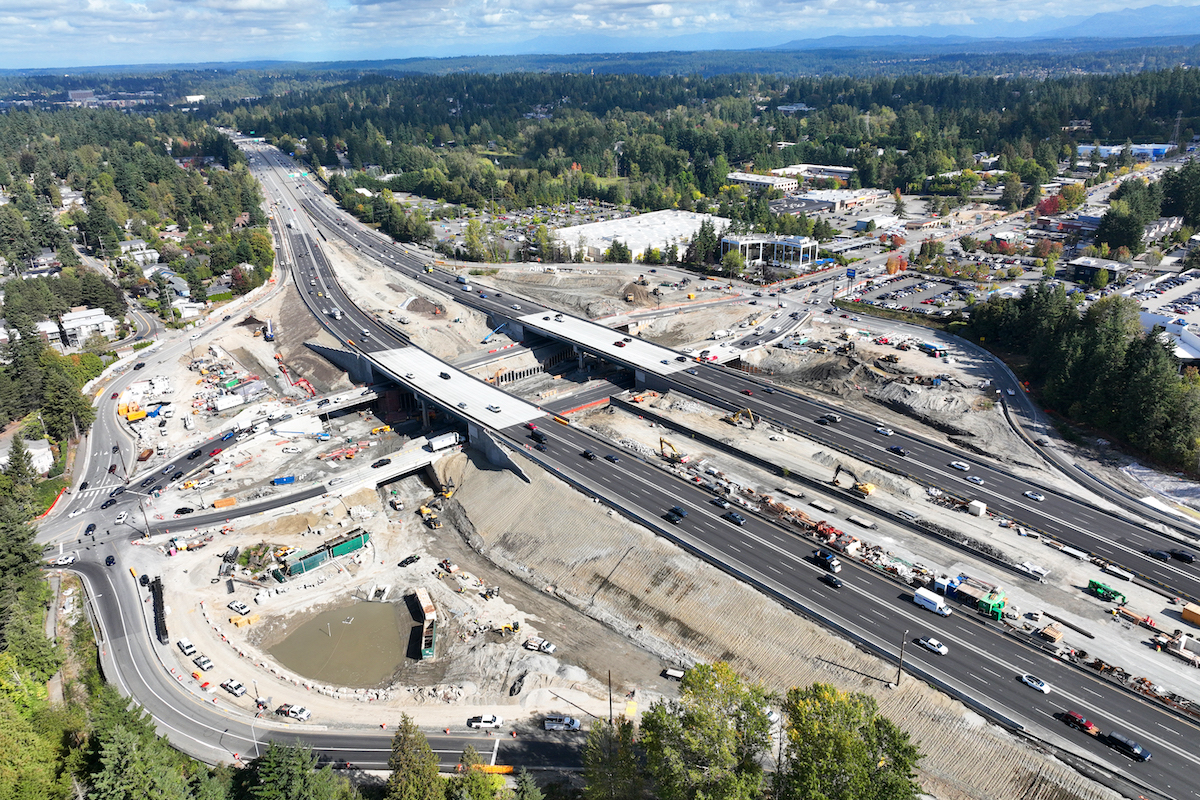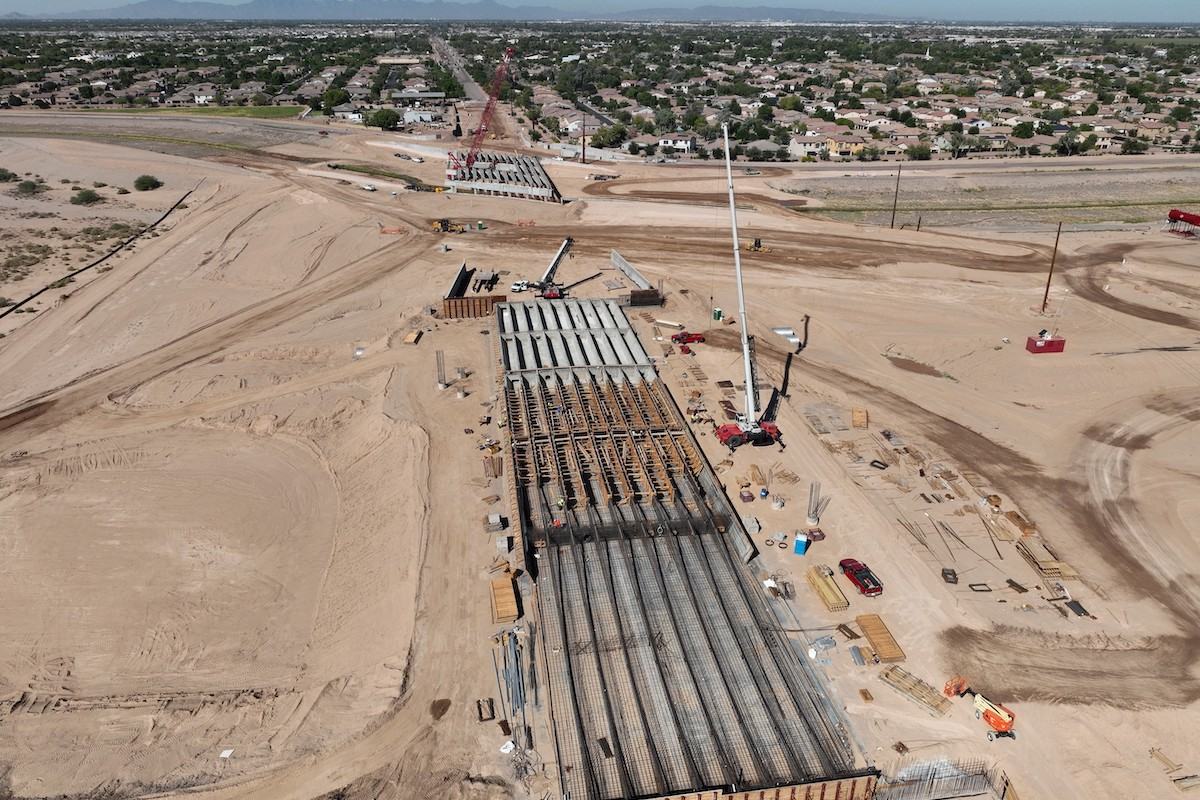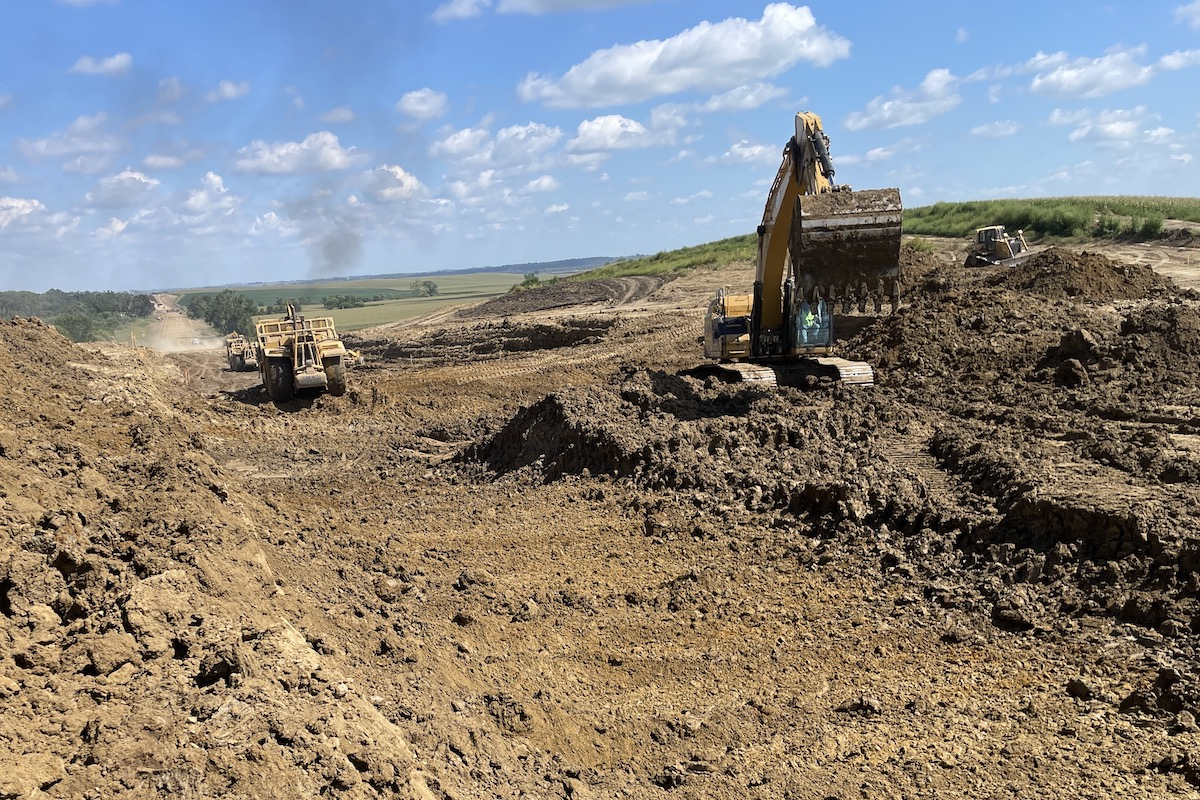Along the Ocean Highway at the border of Georgia and South Carolina, two new bridges under construction will not only accommodate modern truckloads but also withstand a vessel collision, hurricane storm surge, and even a seismic event. Design-build delivery allowed the team to maximize the contractor’s strengths while minimizing project costs and impacts to area marshlands.
The $65.5 million, federally funded project, won by Scott Bridge Company, Inc., and designer Michael Baker International, bundles the replacement of two bridges on Georgia Highway 25 over the Savannah and Middle Rivers in Chatham County: the James P. Houlihan Bridge and the Middle River Bridge.
The Houlihan Bridge, with its steel, green trusses and hexangular wheelhouse, one of the oldest bridges in Georgia and the last working swing-span bridge in the state, was originally constructed in 1922. Replacement construction on the two-lane bridge began 100 years later in Q3 2022 and finished early, in Q3 2024. Construction on the Middle River Bridge is underway.
According to the Federal Highway Administration, both the Houlihan Bridge and the Middle River Bridges were two of the only bridges listed in “poor condition” and in need of replacement in Chatham County.
The former Houlihan Bridge carried a two-lane state highway over the navigable Front River channel of the Savannah River at Port Wentworth. SR 25 is also the main access route for the state’s ports, a large source of economic activity. Both the age of the bridge and the high volume of commercial vehicles helped to fast-track the project.

| Your local Trimble Construction Division dealer |
|---|
| SITECH Allegheny |
| SITECH Northeast |
“This is one of the routes out of Georgia to South Carolina, so there's a lot of truck traffic on this route,” said Al Bowman, Vice President and Savannah River Bridge Project Manager, Michael Baker International. “The Georgia Department of Transportation [GDOT] is excited to offer a more reliable route to the trucking industry and everybody that's going to use this road regularly.”
The new bridges will allow more trucks into South Carolina and away from GA-21, especially as traffic and business continues to surge at the Port of Savannah.
The former Houlihan Bridge stood 7 to 11 feet above the water, depending on tide levels. Similar to other swing bridges, the Houlihan Bridge detached on both ends, rotating 90 degrees on a vertical axis to allow ships and barges to pass through on either side of its structure. But over time, the style has waned in popularity, replacement parts have become increasingly difficult to find, and the swinging style caused constant traffic delays.
“Obviously, there was a tremendous delay every time they have to open the bridge. And as old as it is, it was subject to breakdown,” Bowman said. “If it were to get stuck in the open position, that would really be a problem for all the highway users. So there was a big concern about getting it out of their inventory.”

| Your local Trimble Construction Division dealer |
|---|
| SITECH Allegheny |
| SITECH Northeast |
The swing bridge was replaced with a high-level, fixed-span bridge, raising the roadway to 55 feet minimum vertical clearance at mean low tide and clearing a 100-foot-wide channel, as required by the United States Coast Guard. The new bridge also features wider shoulders designed for modern passenger and commercial vehicles.
“The Houlihan Bridge had no clearance, that's why it had to swing open for sailboat traffic and some speedboats to go through,” Bowman said. “So now it is restricted to a 55-foot mast height, which will accommodate most of the traffic that's going to traverse this waterway. If you’re taller than that, you need to find another way around. You're a pretty serious ship.”
In order to maintain traffic, contractors built on parallel offset alignment, allowing the traffic to stay on the existing road while they were constructing the new bridge.
From its origins in the Blue Ridge Mountains to its termination as a coastal estuary, the Savannah River and its tributaries are thought to sustain some of the world’s most diverse and biologically rich ecosystems. The Nature Conservancy of Georgia describes the Savannah River Basin’s ecological diversity as “rivaling that of a South American rain forest.” Because of this, extra care needs to be given to any work performed in the river’s marshlands.

| Your local Trimble Construction Division dealer |
|---|
| SITECH Allegheny |
| SITECH Northeast |
The GDOT base proposal included costing plans to create the new Savannah River Bridge. However, during the bid process the design-build team was able to design to the strengths of Scott Bridge Company and their means and methods of construction while minimizing impacts to the Savannah River and adjacent salt marshes, allowing them to win the contract.
“We were able to work with the contractors, finding the minimum width of work bridge that they needed and squeez[ing] the work bridge in between the existing bridge and the new bridge we were going to construct,” Bowman said.
“That minimized a lot of fill in the wetlands and a lot of work bridge, which saved a lot of money. Secondarily, with our design we opted to extend the bridge itself and minimize the number of slopes to the bare minimum, which also saved a lot of impacts to the wetlands. And the salt marsh credits are super expensive; that's one place where we got savings.
“That’s the beauty of a design-build job: because you get to maximize the efficiencies of your contractor and how they are able to build things. That's where you save time and money — how quickly the whole thing is to get it designed and get it to construction. Once it's in their hands, they can do what they do best.”

| Your local Trimble Construction Division dealer |
|---|
| SITECH Allegheny |
| SITECH Northeast |
The Scott Bridge Company was able to self-perform pile driving, so Michael Baker International maximized the number of pile bent foundations to minimize the impacts to the wetlands.
“We had to go through analysis to balance that — what made the most sense, maximizing the efficiency of the contractor, and also minimizing impacts,” Bowman said.
According to Bowman, driving piling in marsh conditions has two big challenges, one of which is the depth of the soft, marsh soils because there is nothing to support a piling. The longer the piling goes without support, the bigger the piling needed, and that requires larger equipment to drive the bigger piling. The second challenge is the sudden hard and compacted deposits of sand that occur within the soft, silty marsh soil.
“You have to get through those layers, and it's a real challenge to the pile driving. It was a big celebration for us when we completed all foundations on the job,” Bowman said.

| Your local Trimble Construction Division dealer |
|---|
| SITECH Allegheny |
| SITECH Northeast |
Bowman’s team performed a detailed pile drive analysis in the challenging locations. In areas where it was particularly challenging, Bowman’s team opted to do a pile driving analysis on every individual piling.
“In sands, you get lateral support of the piling almost immediately, but in the silts you don't. These piles are typically 80 feet long,” Bowman said. “The pile driving analysis was very helpful to them. It tells them in real time what capacity they have, and as soon as they hit it, they stop.”
The Low Country may not be known for earthquakes. However, although rare, scattered earthquakes along the coastal plains have caused significant damage. In 1886 in Charleston, South Carolina, for example, an earthquake thought to have been a magnitude of 7.6 killed more than 100 people and destroyed hundreds of buildings. The coastal area around Savannah, Georgia, at the tail end of the Charleston fault zone, is thought to be mainly where seismic activity will come into play.
In preparation for possible seismic episodes, the team installed earthquake drains at the abutments to mitigate slope failures in the event of an earthquake, one of the first times they have been used in the state of Georgia.

| Your local Trimble Construction Division dealer |
|---|
| SITECH Allegheny |
| SITECH Northeast |
“The drains mitigate the potential for the slopes to fail by allowing the water to come out of the soil and exit from the mass, and that stops the slope from completely failing,” Bowman said. “It comes down to what they call ‘liquefiable soils’ because those soils in the marshes have so much water in them. Water is like a lubricant; when it starts vibrating, it really makes the particles want to just fall down the hill. And by removing that water from that mass, it gives much more stability to the soil.”
The team also performed a storm surge analysis to determine the water’s potential height in that area, ensuring the bridge superstructures would clear it.
“The piling foundations can handle it because they don't have a lot of surface area, but you don't want the storm surge to hit the beams,” Bowman said. “A wall of water creates a tremendous amount of force. So we ensured that the beams are clear of the 25-year storm surge. This should accommodate nearly every storm expected on the Georgia coast.”
“We had a great project team from the beginning,” Bowman said. “We've done a lot of work with Scott Bridge on design-build projects. From day one, it was a 100 percent collaboration and still is to this day.

| Your local Trimble Construction Division dealer |
|---|
| SITECH Allegheny |
| SITECH Northeast |
“The Georgia DOT has also been very helpful and a great partner in the process and helping us to get there. There's a lot to do and a lot of checklists you got to go through to open a new bridge to traffic. And they were right with us all along, making sure that we had everything that is going to satisfy their requirements.
“From the very beginning, I said in one of our collaboration meetings that everyone needs to keep rowing and not be an anchor, and they really have held that up.”
The team has now moved on to the second part of the project, constructing the Middle River Bridge. They will shift traffic to the new bridge in the coming months, then Scott Bridge Company will proceed with the removal of the old bridge at Middle River.
“We've coordinated a plan for doing that activity with the Georgia Department of Natural Resources to ensure that there's going to be no harm to endangered species in the river,” Bowman said.

| Your local Trimble Construction Division dealer |
|---|
| SITECH Allegheny |
| SITECH Northeast |
The overall project completion is scheduled for Q4 2025.








